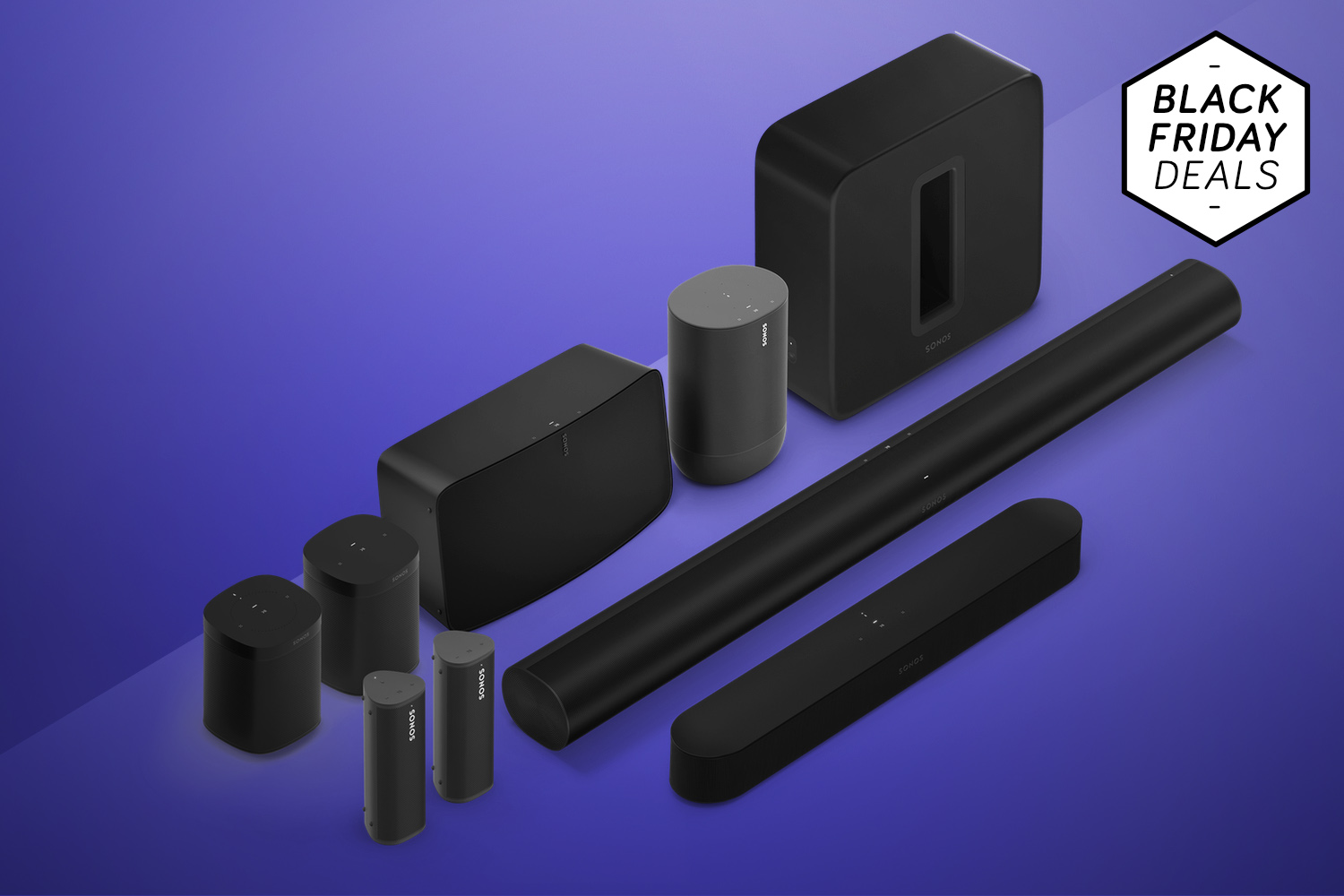Deeper Dive: Our Top Tested Picks
Best Wi-Fi 6 Router Overall
Synology WRX560
- Easy installation
- Excellent throughput and signal performance
- Built-in parental-control and network-security software
- Mesh-ready
- Multi-gig WAN/LAN
- Middling file transfer performance
- Top heavy design
Superior throughput performance, wide signal coverage, and a slick menu system make the Synology WRX560 an excellent choice among dual-band Wi-Fi 6 routers. The router turned in some of the highest throughput scores we’ve seen in its category. It also comes with strong parental control and network security software, and is equipped with a multi-gig WAN/LAN port, You can even use it as part of a whole-home mesh configuration should you want to expand your network later on.
Anyone who wants an excellent value from a Wi-Fi 6 router for a small or medium-sized home should give the WRX560 a look. It’s especially attractive to people who own a Synology network attached storage (NAS) drive, since it uses a similar interface to the ones those devices use, which makes configuring the router easy.
Wireless Specification
802.11ax
Wi-Fi Speed (Total Rated Throughput)
AX3000
Number of Wired LAN Ports (Excluding WAN Port)
4
Number of USB ports
1
Number of Antennas
6
Number of Bands
2
Wireless Networking Security
WPA2, WPA3
Learn More
Synology WRX560 Review

Best Budget Wi-Fi 6 Router
Reyee RG-E5 Wi-Fi 6 Router
- Reasonably priced
- Easy to install
- Excellent throughput performance
- Strong signal performance
- No USB ports
- Lacks multi-gig WAN/LAN
- Does not support WPA3
- Lacks 160MHz channel bandwidth
The Reyee RG-E5 delivered the best 5GHz throughput performance we’ve seen from a midrange Wi-Fi 6 router, and it did a fine job of bringing strong Wi-Fi signals to all corners of our test home. It doesn’t support 160MHz channel bandwidth or WPA3 encryption and it lacks multi-gig WAN and USB ports, but those features are typically found on more expensive routers.
If you don’t have the budget—or the need—for features like high-speed I/O ports and 160MHz channels, the Reyee RG-E5 could be the Wi-Fi 6 router of your dreams. It offers impressive performance for a midrange router and comes with basic parental controls, as well as a smart home feature that creates a separate 2.4GHz SSID that can be used exclusively by smart devices such as thermostats, door locks, and cameras.
Wireless Specification
802.11ax
Wi-Fi Speed (Total Rated Throughput)
AX3200
Number of Wired LAN Ports (Excluding WAN Port)
4
Number of USB ports
0
Number of Antennas
8
Number of Bands
2
Wireless Networking Security
WPA, WPA2
Learn More
Reyee RG-E5 Wi-Fi 6 Router Review

Best Wi-Fi 6E Router
TP-Link Archer AXE75
- Easy to install
- Reasonably priced
- 6GHz transmissions
- Solid throughput performance
- Includes HomeShield software
- Mesh ready
- Middling file transfer performance
- No multi-gig ports
- Some features require a subscription
The Archer AXE75 is not only an excellent Wi-Fi 6 router, but it also adds support for 6GHz transmissions known as Wi-Fi 6E, making it one of the most cutting-edge, too. Being able to future-proof your network for under $200 is a winner in our book. The Archer AXE75 is a pioneer in bringing 6E down as low as we’ve seen it in price. The perk: Enjoy the lack of in-air competition while you can, as the 6GHz radio band should remain uncrowded for a bit, until wider Wi-Fi 6E adoption takes hold. Beyond the price, the AXE75 a solid performer. All you need is to start collecting 6E-compliant client devices to leverage this bargain router to the max.
Anyone thinking about hopping aboard the 6GHz Wi-Fi train but unwilling to spend a bundle, your engine has arrived. Parents will also be pleased to learn that the AXE75 includes access to HomeShield Basic, TP-Link’s strong parental controls and basic network security tools. You can block internet access for individual users, apply age-based filtering, and see how long a user has been online. (Opting for a monthly or annual paid plan can give you even more control.)
Wireless Specification
802.11ax with 6E
Wi-Fi Speed (Total Rated Throughput)
AXE5400
Number of Wired LAN Ports (Excluding WAN Port)
4
Number of USB ports
1
Number of Antennas
6
Number of Bands
3
Wireless Networking Security
WPA2, WPA3
Learn More
TP-Link Archer AXE75 Review

Best Wi-Fi 6 Gaming Router (Tri-Band)
TP-Link Archer AX11000 Next-Gen Tri-Band Gaming Router
- Easy to install
- Lots of gamer-friendly settings
- Numerous ports
- Multi-gig WAN. Link aggregation
- Lifetime malware protection
- Solid parental controls
At just under $400, the Archer AX11000 isn’t what you would call a bargain router, but it’s a stellar performer that’s chock-full of features. This massive router gives you eight 1GbE LAN ports, a 2.5GbE WAN port, a USB-C port, and support for link aggregation. It delivered blazing throughput and file-transfer performance in testing and comes with free parental controls and malware protection.
Hardcore gamers who don’t mind paying a premium for a tri-band Wi-Fi 6 router with killer components and killer performance should look no further than the Archer AX11000. Its gaming dashboard lets you manage bandwidth allocation, view real-time data rates and resource usage, and check internet upload and download speeds. There’s also a Game Accelerator option that helps reduce latency and speed up online gaming performance.
Wireless Specification
802.11ax
Wi-Fi Speed (Total Rated Throughput)
AX11000
Number of Wired LAN Ports (Excluding WAN Port)
8
Number of USB ports
2
Number of Antennas
8
Number of Bands
3
Wireless Networking Security
WPS, WPA2, WPA3
Learn More
TP-Link Archer AX11000 Next-Gen Tri-Band Gaming Router Review

Best Wi-Fi 6 Gaming Router (Dual-Band)
Asus ROG Rapture GT-AX6000
- Excellent performance
- Easy to install and manage
- Multi-gig connectivity
- Lots of gamer-friendly settings
- Free network security and parental control software
- Expensive
- Wi-Fi 6, not 6E
Excellent throughput and signal range performance, high-end hardware, and a wealth of cool gaming features earned Asus’ ROG Rapture GT-AX6000 an Editors’ Choice award among premium gaming routers. You don’t get eight LAN ports as you do with the TP-Link Archer AX11000, but you get dual 2.5GbE LAN/WAN ports and four 1GbE LAN ports with support for link aggregation. You can also dedicate one of the LAN ports for gaming purposes and give it bandwidth priority.
The Rapture is an excellent choice for players who crave a Wi-Fi 6 router that will elevate their online gaming prowess. It’s far from cheap at just under $400, but its superb performance, game-enhancing settings, and lifetime parental control and network security tools make it money well spent. Choosing between it and the AX11000 comes down to whether you’re willing to sacrifice one of the Rapture’s multi-gig ports for four additional 1GbE LAN ports.
Wireless Specification
802.11ax
Wi-Fi Speed (Total Rated Throughput)
AX6000
Number of Wired LAN Ports (Excluding WAN Port)
5
Number of USB ports
2
Number of Antennas
4
Number of Bands
2
Wireless Networking Security
WPA2, WPA3
Learn More
Asus ROG Rapture GT-AX6000 Review

Best Wi-Fi 6E Gaming Router
Acer Predator Connect W6 Wi-Fi 6E Router
- Easy to configure
- Solid throughput and file transfer performance
- Supports 6GHz transmissions
- Lifetime network security and parental controls
- Pricey
- Middling signal strength performance
- Mobile app offers limited functionality
With the Acer Predator Connect W6 Wi-Fi 6E Router, you can take advantage of the speedy and uncluttered 6GHz radio band, and use the router’s gamer-friendly QoS settings to ensure maximum throughput when needed. It uses Intel’s Killer Prioritization Engine and Acer’s Hybrid QoS features to allow gamers to give bandwidth priority to devices and applications at the same time. You’ll also find an Nvidia GeForce Now setting that provides optimized bandwidth settings for GeForce Now gaming clients, and a Max Throughput setting that enables maximum throughput with NAT acceleration and no bandwidth limitations.
With its backlit LEDs, sleek grillework, and impressive hardware specs, the Predator Connect is obviously designed with gamers in mind.
Wireless Specification
802.11ax with 6E
Wi-Fi Speed (Total Rated Throughput)
AXE7800
Number of Wired LAN Ports (Excluding WAN Port)
4
Number of USB ports
1
Number of Antennas
6
Number of Bands
3
Wireless Networking Security
WPA2, WPA3
Learn More
Acer Predator Connect W6 Wi-Fi 6E Router Review

Best Wi-Fi 6E Mesh System
Wyze Wi-Fi 6E Mesh Router Pro
- Reasonably priced
- Wi-Fi 6E support
- Strong 5GHz throughput performance
- Multi-gig Ethernet and USB connectivity
- Built-in network security software
- Low-profile nodes
- Lacks strong parental controls
- Limited settings
This two-piece system is a trifecta: 6GHz support for future-proofing your network, solid throughput performance on the 5Ghz band, and a reasonable price of $273.99. In our tests, Wyze’s Wi-Fi 6E mesh system did a great job of delivering strong Wi-Fi signals throughout our test home. The built-in network security software is integrated into the easy-to-use mobile app, which you probably already have if you own other Wyze smart home devices. If your home is smaller, you can order a single router for $179.98, which covers 2,000 square feet. If you need to go bigger, you can opt for a three-pack for $393.99 that covers 6,000 square feet.
The Deco W7200 is a good choice for anyone seeking a midrange mesh system that delivers strong 5GHz coverage, as well as offers 6GHz (Wi-Fi 6E) support for future-proofing. If you need to spread reliable Wi-Fi throughout a home up to 4,000 square feet—especially if that home already has other Wyze devices—the Mesh Router Pro two-pack is an excellent choice that won’t break the bank.
Wireless Specification
802.11ax with 6E
Wi-Fi Speed (Total Rated Throughput)
AX5400
Number of Wired LAN Ports (Excluding WAN Port)
1 on main router, 2 on node
Number of USB ports
1
Number of Antennas
6
Number of Bands
3
Wireless Networking Security
WPA2, WPA3
Learn More
Wyze Wi-Fi 6E Mesh Router Pro Review

Best Wi-Fi 6 Router for Multi-Gig Wired Connections
Asus ROG Rapture GT-AX11000 Pro
- Blazing throughput speeds
- Wide signal coverage
- 10Gbps LAN/WAN
- Lifetime parental control and network security software
- Lots of gamer-centric settings
- Expensive
- Large footprint
The Asus ROG Rapture GT-AX11000 Pro offers some of the most advanced features we’ve seen in a desktop router. As a tri-band AX11000 router, it can hit maximum speeds of up to 1,148Mbps on the 2.4GHz band and up to 4,804Mbps on each of the two 5GHz bands. But the real stars of the show are the wired speeds. This well-equipped router provides a 10Gbps LAN/WAN port, a 2.5Gbps WAN port, and four 1Gbps LAN ports. If those already-screaming top wired speeds aren’t enough for your needs, the router also supports link aggregation, offering the potential for truly massive bandwidth and future-proofing.
Gaming enthusiasts and users who need multiple high-speed networking ports shouldn’t be put off by the $450 price tag. You get plenty of bang for your buck, ranging from lightning-fast speeds to a slew of game-enhancing settings and lifetime network security and parental control software.
Wireless Specification
802.11ax
Wi-Fi Speed (Total Rated Throughput)
AX11000
Number of Wired LAN Ports (Excluding WAN Port)
5
Number of USB ports
2
Number of Antennas
8
Number of Bands
3
Wireless Networking Security
WPA2, WPA3
Learn More
Asus ROG Rapture GT-AX11000 Pro Review

Best-Looking Wi-Fi 6 Router
D-Link Aquila Pro AI AX6000 Dual-Band Wi-Fi 6 Router (M60)
- Solid performance
- Mesh ready
- Multi-gig WAN
- Free parental controls
- Stylish design
- Lacks network security software
- No USB ports
- No multi-gig LAN
While the D-Link Aquila Pro M60 isn’t a top performer or particularly feature-rich as Wi-Fi 6 routers go, it does offer one of the most noteworthy physical designs we’ve seen. The M60 has a matte white and light blue enclosure with two fins on either side that curve up and in. D-Link says the design is eagle-inspired—perhaps the fins are supposed to be curved wings—but it really looks more like a manta ray. Either way, it’s sure to be a talking point if a visitor spots it in your home.
Some people like their routers to blend in with their home decor, while others like them to stand out. If you’re in the second category, you can’t get much more distinctive than this Wi-Fi 6 router masquerading as a manta ray.
Wireless Specification
802.11ax
Wi-Fi Speed (Total Rated Throughput)
AX6000
Number of Wired LAN Ports (Excluding WAN Port)
4
Number of USB ports
0
Number of Antennas
8
Number of Bands
2
Wireless Networking Security
WPA2, WPA3
Learn More
D-Link Aquila Pro AI AX6000 Dual-Band Wi-Fi 6 Router (M60) Review
Buying Guide: The Best Wi-Fi 6 Routers for 2024
For those new to Wi-Fi 6, it’s good to cover exactly what this new standard entails and why it’s important. Wi-Fi 6 is another name for 802.11ax, the primary standard for today’s wireless tech. Wi-Fi 6’s primary benefit over Wi-Fi 5 is a theoretical throughput bounce from 5.4Gbps to a maximum of 9.6Gbps. But you’ll find more to Wi-Fi 6 than faster speed, including greater client capacity, better range performance, and reduced network congestion and power consumption.
Wi-Fi 6 also adds entirely new capabilities to your router’s arsenal, such as the Orthogonal Frequency-Division Multiple Access (OFDMA) protocol. OFDMA enhances throughput by breaking Wi-Fi channels into sub-channels and allowing up to 30 users to share a channel simultaneously. Target Wake Time (TWT) is a power reduction scheme that allows Wi-Fi 6 devices to decide when they will emerge from a power-saving sleep mode to begin sending and receiving data. Smart devices such as security cameras and video doorbells are expected to benefit from TWT technology, as are smartphones, tablets, and laptop PCs.

(Credit: Netgear)
Another area of improvement is channel size. Wi-Fi 6 doubles the channel width from 80MHz to 160MHz. This expansion helps create faster connections between the router and its clients. It also broadcasts over previously unused radio frequencies to deliver faster throughput performance over the 2.4GHz radio band. Uplink and downlink MU-MIMO streaming are also on the menu, as is enhanced Quality of Service (QoS) via uplink and downlink bandwidth management, and WPA3 encryption.
After the rollout of Wi-Fi 6, the Federal Communications Commission (FCC) opened up parts of the 6GHz spectrum for unlicensed use. This newer technology, dubbed Wi-Fi 6E, offers 1,200MHz of new spectrum and support for multiple non-overlapping 80MHz and 160MHz high-speed channels. In a nutshell, Wi-Fi 6E means more bandwidth and faster throughput. To take advantage of all this newfound bandwidth, you’ll need a router that supports Wi-Fi 6E and clients that can connect to the 6GHz radio band. (See our explainer on Wi-Fi 6E.)
What Important Features Should I Look for in a Wi-Fi 6 Router?
As with any router, you’ll find that Wi-Fi 6 routers come with a wide variety of features that can bring specific benefits, though typically with the side effect of a bigger dent in your wallet. The big benefit is higher performance, but other benefits are available, as well. Router models with a specific focus, especially gaming routers, tend to include features specific to that specialty while ignoring other capabilities, so be sure you’re getting everything your network will need.
If you’ll be connecting wired devices like gaming consoles, home automation hubs, and network attached storage (NAS) drives, look for a router that has at least four LAN ports. Many high-end Wi-Fi 6 routers support link aggregation, which utilizes two gigabit LAN ports to provide increased throughput for things like large file transfers and network traffic load balancing. This also helps serve as a fail-safe in the event that one LAN port stops working. Some of the more advanced models are equipped with multi-gig LAN ports that can handle 2.5Gbps, 5Gbps, and 10Gbps connection speeds.
If you’re looking to hard-connect peripherals such as printers and external hard drives to your network, make sure your Wi-Fi 6 router is equipped with at least one USB 3.0 port. Two or more USB ports are even better as they let you connect multiple devices without having to unplug one to connect another. With an external drive, a quick USB port, and router software that supports it, you can build your own secure NAS device that’s accessible from not only your network but the internet.

(Credit: Netgear)
If there’ll be kids connecting to your network, make sure they stay safe on the internet and look for a Wi-Fi 6 router that comes with built-in parental controls. Most routers come with basic parental controls that let you create access schedules, block certain websites, and deny internet access to specific devices on your network. But if you really want to keep tabs on your child’s online activities, you’ll need more granular controls. Many Wi-Fi 6 routers come with free or try-and-buy versions of parental control software that works with your phone and a mobile app, and lets you do things like pause internet access with a single click or create profiles for each member of your family. The more robust controls let you monitor site visits and total online time usage. They also offer customizable age-based presets that will automatically block access to social media platforms and sites that contain things like adult content, gambling, shopping, torrent downloads, and online gaming.
In that vein, any network should make security a priority, which means thinking about antivirus and malware protection. Some Wi-Fi 6 routers come with software that protects your network and all of your connected clients from viruses, phishing schemes, spyware, adware, and other cyber threats. Look for anti-malware tools that will detect malware in real time, quarantine infected devices, and remove malicious content from client devices. More often than not, anti-malware tools are bundled along with parental controls and come with free trial subscriptions, although a handful of router vendors offer free lifetime subscriptions.
An oft-overlooked aspect of network security is visitors. If you’re going to entertain guests in your home or office and offer them wireless network access, do you really want to give them complete access? Nearly all of today’s Wi-Fi 6 routers offer a guest networking feature that lets you grant internet access to visitors, using a separate SSID and password, without giving them full access to everything else connected to your network, like NAS devices, printers, and all your laptops and desktop PCs.
Last, if your house has one or more online gamers vying for bandwidth, or if you do a lot of high-res video streaming, make sure your Wi-Fi 6 router offers strong Quality of Service (QoS) settings that let you allocate bandwidth to specific client devices or protect certain kinds of network traffic. Some QoS implementations allow you to enter an actual number (in Mbps) to make sure devices like gaming consoles and smart TVs have adequate bandwidth for lag-free gaming and smooth 4K video streaming; other schemes offer presets for specific applications. Simply tap a button to grant or revoke priority bandwidth for any device on your network.
What Specifications Should I Look for in a Wi-Fi 6 Router?
You’ll see Wi-Fi 6 routers with designations like “AX1500” or “AX11000,” which tell you the maximum combined data rate. For example, a dual-band AX1500 router is capable of reaching speeds of up to 300Mbps on the 2.4GHz band and up to 1,201Mbps on the 5GHz band, while a tri-band AX11000 router gets you combined speeds of up to 1,148Mbps on the 2.4GHz band and up to 4,804Mbps on each of two 5GHz bands. It’s important to note that these are theoretical combined speeds (mostly used for marketing purposes) and not the actual all-the-time speed of a router. In reality, a router is only as fast as its fastest radio band, and even then, that number is arrived at under ideal laboratory conditions and not what you’ll see in real-world use. (For much more on decrypting these numbers, see our guide.)
Other specs to consider are the number of radio bands, the processor (CPU) type, and the amount of flash memory and RAM that a router uses. As hinted above, dual-band routers use one 2.4GHz radio and one 5GHz radio, while tri-band routers use a single 2.4GHz band and two 5GHz bands. Tri-band routers are ideal for high-traffic networks because you can designate specific radio bands to certain applications. For example, you can perform large file transfers over one of the 5GHz bands, which frees up the other two bands for things like web surfing and video streaming.

(Credit: Shutterstock/Deutschlandreform)
As with desktop and laptop PCs, beefier specs mean faster speeds. Look for a Wi-Fi 6 router with a quad-core CPU and at least 512MB of RAM and 512MB of flash memory. Additionally, more antennas typically provide better overall wireless coverage, which is why you’ll see as many as eight antennas on high-end routers.
Another important and rather broad spec to consider is whether you want a Wi-Fi 6 router or a Wi-Fi 6 mesh networking system. While Wi-Fi 6 mesh systems are relatively new to market, they offer potentially easier setup and more even coverage for larger homes. For more details, read about The Best Wi-Fi Mesh Network Systems. And once you’ve purchased one, check out our primer, How to Set Up a Wi-Fi Mesh Network.
Is It Worth Paying More for a Wi-Fi 6 Router?
As with all other types of routers, Wi-Fi 6 router pricing is based on hardware specs, performance capabilities, and features. Budget Wi-Fi 6 routers can cost anywhere from $50 to well above $200, but these are typically bare-bones, dual-band models that use low-end components such as dual-core CPUs, offer low data rates, and lack features such as USB ports, anti-malware software, and multi-gig LAN ports.
At the other end of the spectrum, a high-end Wi-Fi 6E router designed for gaming can cost upward of $600. For that kind of money, you get all the bells and whistles, including multi-gig LAN, AXE11000 speeds, three radio bands, built-in malware protection and parental controls, quad-core processing, and a dedicated gamer-friendly operating system.

(Credit: Amazon)
With all this in mind, take a look at the top-performing Wi-Fi 6 routers we’ve tested so far and compare them spec by spec. Once you’ve found the right router, read our tips for setting up your router and boosting your Wi-Fi signal.










